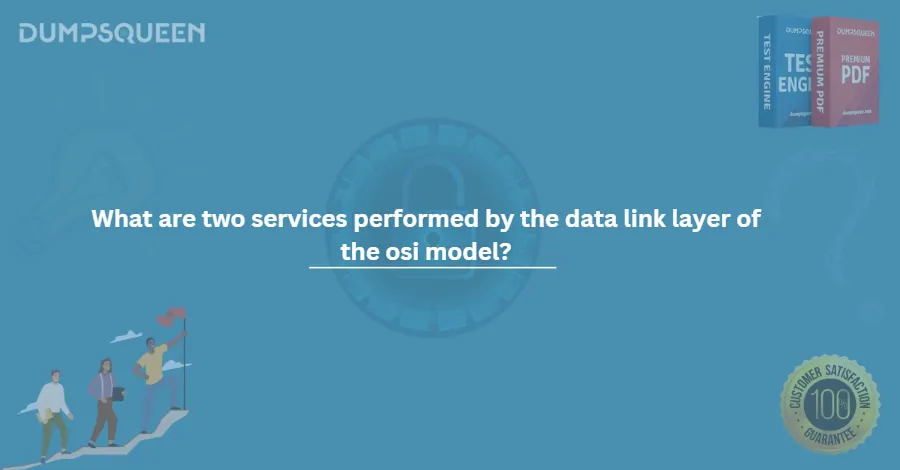Understanding the OSI Model and the Data Link Layer: A Deep Dive with DumpsQueen
Networking is the backbone of modern technology, enabling everything from simple emails to complex cloud-based systems. For anyone looking to master this field—whether you're a student, an IT professional, or a certification aspirant—the OSI Model is an essential framework to understand. It’s a conceptual blueprint that standardizes the functions of a communication system into seven distinct layers. If you’re preparing for certifications like CompTIA Network+, CCNA, or even just brushing up your skills, resources like DumpsQueen can be your ultimate companion. In this blog, we’ll explore the OSI Model briefly, zoom into the Data Link Layer, uncover its key services, and touch on some additional functions—all while highlighting how DumpsQueen can empower your learning journey.
Brief Overview of the OSI Model and Its Significance in Networking
The Open Systems Interconnection (OSI) Model, developed by the International Organization for Standardization (ISO), is a seven-layer framework that breaks down the complex process of network communication into manageable, modular parts. These layers are Physical, Data Link, Network, Transport, Session, Presentation, and Application. Each layer serves a specific purpose, interacting with the layers above and below it to ensure seamless data transfer across diverse systems.
Why is the OSI Model so significant? Imagine trying to troubleshoot a network issue without knowing where to start—chaos, right? The OSI Model provides a universal language for engineers and technicians, allowing them to pinpoint problems efficiently. It’s also a cornerstone of networking education, forming the basis for countless certification exams. Whether you’re decoding packet loss or configuring a router, understanding the OSI Model is non-negotiable.
For learners, though, the OSI Model can feel overwhelming at first. That’s where DumpsQueen comes in. With its comprehensive study materials, practice questions, and real-world examples tailored to networking concepts, DumpsQueen simplifies the learning curve. It’s like having a personal tutor guiding you through each layer, ensuring you not only memorize but truly understand the material.
Now, let’s narrow our focus to one of the most critical layers in this model: the Data Link Layer.
Definition of the Data Link Layer
The Data Link Layer is Layer 2 of the OSI Model, sitting just above the Physical Layer and below the Network Layer. Its primary role is to ensure reliable data transfer between two directly connected nodes—think of it as the bridge that gets data safely across a single hop in a network. It takes the raw bits transmitted by the Physical Layer and organizes them into structured frames, adding essential control information along the way.
But it’s more than just a data organizer. The Data Link Layer handles error detection and correction, manages access to the shared physical medium (like an Ethernet cable or Wi-Fi channel), and ensures that data arrives intact and in the right order. In essence, it’s the layer that makes local communication reliable and efficient.
For anyone diving into networking—especially those using DumpsQueen to prep for exams—the Data Link Layer is a goldmine of testable concepts. From MAC addresses to Ethernet frames, DumpsQueen resources break down these topics into digestible chunks, complete with diagrams and practice scenarios. It’s no wonder why so many learners swear by it as their go-to study aid.
Two Key Services Provided by the Data Link Layer
The Data Link Layer offers several services, but two stand out as its core contributions: error control and media access control (MAC). Let’s explore these in detail and see how DumpsQueen can help you master them.
1)Error Control
Networks aren’t perfect. Data can get corrupted due to noise, interference, or hardware glitches as it travels across cables or airwaves. The Data Link Layer steps in with error control mechanisms to detect and, in some cases, correct these issues before passing the data up to the Network Layer.
How does it work? The layer adds error-detection bits—like parity checks or Cyclic Redundancy Check (CRC)—to each frame. When the receiving node gets the frame, it recalculates these bits. If they don’t match, an error is flagged, and the frame might be retransmitted (depending on the protocol). Some advanced implementations even allow for error correction without retransmission, though this is less common.
For example, in an Ethernet network, the Data Link Layer uses CRC to ensure data integrity. This is critical in real-world scenarios—imagine a file transfer failing because of a single corrupted bit. Error control prevents that nightmare.
DumpsQueen shines here by offering detailed explanations of error control techniques, complete with sample questions that mimic certification exams. Whether it’s understanding CRC calculations or troubleshooting error scenarios, DumpsQueen practice tests help you nail this concept with confidence.
2) Media Access Control (MAC)
The second key service is media access control, which governs how devices share the physical medium. In a network, multiple devices might need to send data over the same cable or wireless channel. Without rules, you’d get a mess of collisions—data crashing into each other and becoming unreadable. The Data Link Layer’s MAC sublayer prevents this chaos.
MAC uses protocols like Carrier Sense Multiple Access with Collision Detection (CSMA/CD) in wired Ethernet networks or Carrier Sense Multiple Access with Collision Avoidance (CSMA/CA) in Wi-Fi. These methods ensure that devices “listen” before transmitting and handle collisions gracefully if they occur. The MAC sublayer also assigns unique MAC addresses—those 48-bit identifiers you see on every network interface card—to distinguish devices on a local network.
Think of MAC as the traffic cop of your LAN. It’s what keeps your router, laptop, and smart TV from shouting over each other on the same Wi-Fi network. In practice, understanding MAC is vital for configuring switches, troubleshooting connectivity, or even securing a network against spoofing attacks.
Here again, DumpsQueen proves its worth. Its study guides dive deep into MAC protocols, offering real-world examples—like how CSMA/CD works in a busy office network—and interactive quizzes to test your grasp. For anyone aiming to ace networking certifications, DumpsQueen focus on MAC is a game-changer.
Additional Functions of the Data Link Layer (Optional)
Beyond its core services, the Data Link Layer performs several other functions that enhance its role in networking. While not every exam or scenario demands mastery of these, they’re worth knowing—and DumpsQueen covers them brilliantly for those who want to go the extra mile.
1) Framing
The Data Link Layer doesn’t just pass raw bits—it packages them into frames. A frame includes a header (with source and destination MAC addresses), the payload (the actual data), and a trailer (with error-detection bits). This structure makes data manageable and ensures it’s delivered correctly. DumpsQueen visual aids, like frame diagrams, make this process crystal clear.
2) Flow Control
What happens if a fast sender overwhelms a slow receiver? Data gets lost. Flow control mechanisms, like sliding window protocols, regulate the pace of transmission to match the receiver’s capacity. It’s a subtle but critical function, and DumpsQueen practice problems help you simulate these scenarios.
3) Physical Addressing
The MAC address isn’t just for media access—it’s also the Data Link Layer’s way of identifying devices on a local network. This physical addressing distinguishes Layer 2 from Layer 3 (which uses logical IP addresses). DumpsQueen resources tie these concepts together, showing how they interplay in real networks.
4) Link Management
In some protocols, the Data Link Layer establishes and terminates logical links between nodes, ensuring smooth communication. For example, Point-to-Point Protocol (PPP) used in older dial-up connections relies heavily on this function. DumpsQueen archives even cover these legacy topics, perfect for comprehensive learning.
These additional functions showcase the Data Link Layer’s versatility. With DumpsQueen, you’re not just skimming the surface—you’re diving into the nuances that set you apart as a networking pro.
Conclusion
The OSI Model is more than a theoretical construct—it’s a practical roadmap for understanding and troubleshooting networks. At its heart, the Data Link Layer plays a pivotal role, ensuring reliable, error-free communication between connected devices. Through services like error control and media access control, plus extras like framing and flow control, it lays the groundwork for everything that happens in the layers above.
For anyone serious about networking—whether you’re chasing a certification, a job, or just personal growth—mastering the Data Link Layer is a must. And that’s where DumpsQueen truly shines. With its expertly crafted study materials, practice exams, and real-world insights, it transforms complex concepts into something approachable and conquerable. It’s not just about passing a test; it’s about building a deep, lasting understanding of networking.
So, if you’re ready to take your skills to the next level, give DumpsQueen a try. From the OSI Model to the nitty-gritty of Layer 2, it’s the resource that delivers results. Happy learning, and here’s to acing your networking goals!
Which two services are provided by the Data Link Layer in the OSI model?
a) Data encryption and data compression
b) Error detection and flow control
c) Routing and addressing
d) Data segmentation and reassembly
Answer: b) Error detection and flow control
Which of the following are functions of the Data Link Layer in the OSI model?
a) Packet forwarding and routing
b) Error correction and frame synchronization
c) IP addressing and routing
d) Data encryption and decryption
Answer: b) Error correction and frame synchronization
Which two services are specifically handled by the Data Link Layer in the OSI model?
a) Error detection and local addressing
b) Flow control and packet routing
c) Segmentation and traffic shaping
d) Encryption and connection management
Answer: a) Error detection and local addressing
What are the two primary services offered by the Data Link Layer of the OSI model?
a) Session management and error correction
b) Flow control and access control
c) Packet reassembly and IP addressing
d) Data encryption and error detection
Answer: b) Flow control and access control
In the OSI model, which two services does the Data Link Layer provide to ensure reliable communication?
a) Flow control and frame validation
b) Error detection and packet forwarding
c) Data encryption and session termination
d) Packet routing and header management
Answer: a) Flow control and frame validation




